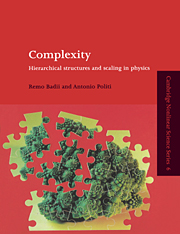Book contents
- Frontmatter
- Contents
- Preface
- Part 1 Phenomenology and models
- Chapter 1 Introduction
- Chapter 2 Examples of complex behaviour
- Chapter 3 Mathematical models
- Part 2 Mathematical tools
- Part 3 Formal characterization of complexity
- Appendix 1 The Lorenz model
- Appendix 2 The horseshoe map
- Appendix 3 Mathematical definitions
- Appendix 4 Lyapunov exponents, entropy, and dimension
- Appendix 5 Forbidden words in regular languages
- References
- Index
Chapter 2 - Examples of complex behaviour
Published online by Cambridge University Press: 20 October 2009
- Frontmatter
- Contents
- Preface
- Part 1 Phenomenology and models
- Chapter 1 Introduction
- Chapter 2 Examples of complex behaviour
- Chapter 3 Mathematical models
- Part 2 Mathematical tools
- Part 3 Formal characterization of complexity
- Appendix 1 The Lorenz model
- Appendix 2 The horseshoe map
- Appendix 3 Mathematical definitions
- Appendix 4 Lyapunov exponents, entropy, and dimension
- Appendix 5 Forbidden words in regular languages
- References
- Index
Summary
In this chapter, we present some of the most frequently quoted examples of “complex” behaviour observed in nature. Far from proposing a global explanation of such disparate systems within a unique theoretical framework, we select those common properties that do cast light on the ways in which complexity exhibits itself.
Natural macroscopic systems are usually characterized by intensive parameters (e.g., temperature T or pressure P) and extensive ones (volume V, number of particles N) which are taken into account by suitable thermodynamic functions, such as the energy E or the entropy S. When the only interaction of a system with its surroundings consists of a heat exchange with a thermal bath, an equilibrium state eventually results: the macroscopic variables become essentially time independent, since fluctuations undergo exponential relaxation. The equilibrium state corresponds to the minimum of the free energy F = E − TS and is determined by the interplay between the order induced by the interactions, described by E, and the disorder arising from the multiplicity of different macroscopic states with the same energy, accounted for by the entropy S.
The commonest case is, however, represented by systems that are open to interactions with the environment, which usually takes the form of a source of energy and a sink where this is dissipated.
- Type
- Chapter
- Information
- ComplexityHierarchical Structures and Scaling in Physics, pp. 12 - 31Publisher: Cambridge University PressPrint publication year: 1997

